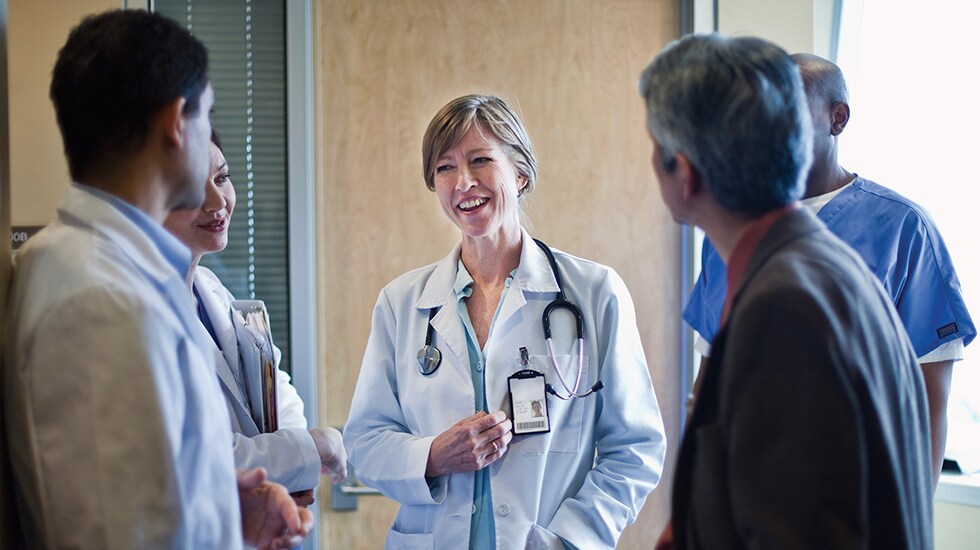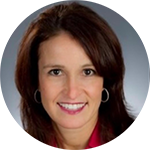How to become a healthcare employer of choice in times of staffing challenges – Q&A with Hackensack Meridian Health
Oct 31, 2023 | 5 minute read
Workforce shortages are a top concern for healthcare leaders worldwide. In a series of articles, we have invited healthcare leaders from different parts of the world to share how they are innovating care delivery to attract, empower and retain staff, and to provide high-quality patient care in more efficient ways. For this edition, we spoke with Hilary Nierenberg, Director of Cardiovascular Care Transformation Services North Region at Hackensack Meridian Health – the largest and most comprehensive integrated healthcare network in New Jersey.

Q: How has Hackensack Meridian Health been affected by staffing challenges, and what has been your response?
A: I think the pandemic heightened the staffing challenges that already existed in healthcare, and Hackensack Meridian Health was no exception in that regard. The additional stress and pressure that many physicians and nurses experienced made some of them question whether they wanted to continue working in healthcare. With hospitals focusing more and more on taking care of the sickest patients, we have also seen some colleagues leaving their job to support sick family members at home.
Our response as an employer has been multi-faceted. It all comes down to the question: how can we become the destination of choice for people who want to work in healthcare? Of course you need to offer competitive salaries, but you also need to create an engaging work environment, where people feel heard and appreciated, and where they feel part of a team. For that, you first need to understand what people value and how they like to be spoken to – which can vary between different segments of the workforce, such as younger and older healthcare professionals. All of this has been a big focus for us at Hackensack Meridian Health.
"There is still nothing more valuable than being able to care for another person. That’s the message I’m hoping to get out there in healthcare.”

Hilary Nierenberg
Director of Cardiovascular Care Transformation Services North Region at Hackensack Meridian Health, New Jersey
Q: Could you break that down for us? What kind of differences have you observed between younger and older healthcare professionals, and how are you accommodating these differences? A: First, we have seen that flexible scheduling is particularly important to younger healthcare professionals. They want the choice to work shorter or longer hours. That calls for a shift in ways of working. For example, in our cath labs, we have been piloting self-scheduling by our staff. It is up to team members to come up with a work schedule for the week, with the right mix of experience levels, which their manager then gets to review and approve – rather than the manager saying, “This is your work schedule.” These pilots have been very successful. We have really seen teams come together and speak up as a group, allowing everyone to voice their desires and concerns. Q: What about healthcare professionals who prefer more traditional communications channels? Q: What else is Hackensack Meridian Health doing to keep its people engaged?
Our experience has been that younger healthcare professionals also prefer different communications platforms. Instead of traditional email newsletters, they want more personal, real-time updates that are instantly accessible via their smartphones. That’s why we have transitioned from email to secure texting in a lot of our communications – whether it’s to celebrate a team member’s work anniversary or to acknowledge them for a job done well.
For example, let’s say someone on one of our care teams found out that a patient had an allergy that was not listed in their medical history, but which was relevant to their treatment. We call that a ‘good catch’, and we immediately send a secure text message to the team to acknowledge the person who spotted it. That makes people feel valued, because others will tell them “I heard you did a great job earlier today.”
A: That’s a good question, because some team members may still prefer to stay in the know via a traditional whiteboard – and you need to recognize and acknowledge that as well. So I think you have to bridge both sides. It’s about meeting people where they are.
For example, in one of our hospitals, we have a big physical whiteboard next to our cath lab, where we keep track of the door-to-balloon time for patients who are brought into the hospital with a heart attack [1]. When the night team did a fast job of taking care of a patient who came in at 3 am, that is visible for everyone to see on the whiteboard the next day. We then also take a photo of the whiteboard to text it to the full team, giving kudos to everyone involved.
Whatever their age or communications preferences, I think everyone wants to feel valued. That goes beyond the work itself and also includes moments that are important to our people on a personal level, such as the birth of a new child or grandchild. We celebrate these moments together. People want to feel seen for more than the job they do. That’s really key to keeping people engaged, I think.
A: For us as a large network with 18 hospitals, it can be challenging to keep our staff and leaders connected across different sites. That’s why we have recently launched a new digital engagement platform, which enables our staff and leaders to check in with each other more regularly, in a highly structured way.
The platform asks people to answer a fixed set of questions every week, such as: What did you like about your work the past week? What did you dislike? What are your priorities for the next week? And do you have any support needs? Once someone submits their answers, their manager gets an alert, and they can send a message back if there’s something they’d like to discuss. So instead of waiting for their next one-to-one meeting, they can now interact more easily and quickly on an ongoing basis.
Using the platform has given me much more visibility into how our frontline workers are doing from week to week. What’s also great about the platform is that it provides me with cues on how I can better engage my people, based on a short survey that identifies my main attributes as a leader. This has been very insightful for me personally. Listening to people’s feedback is also helping us put the right people in the right role, where they feel valued and energized.

Q: Do you see other ways in which digital technologies can support and empower staff? Q: In our Future Health Index 2023 report, healthcare leaders cited automation as another way of addressing staffing challenges. Is that something you are also looking into at Hackensack Meridian Health? A: Yes, absolutely. For example, in some of our community hospitals, we are using robots – coupled with virtual support from a human expert – to assist with the diagnosis of stroke patients. In those smaller community hospitals, there may not always be a neurologist on site. A nurse will then bring in a robot to support with basic neurological tests that help assess the patient’s speech, eye-gaze, etc. A neurologist will call in remotely to make a differential diagnosis based on the test results and decide on the best course of action, which could include further diagnostic imaging or an urgent transfer to another location. I think it is another great example of how technology can augment the capabilities of our clinical staff on site, to help deliver timely and high-quality care to every patient. Q: How can healthcare organizations also keep attracting new talent to future-proof themselves? A: At Hackensack Meridian Health, we’ve been investing in expanding our residency and fellowship programs across our entire network, covering a wide range of roles. We also see a lot of value in partnering with local schools, offering clinical experiences on-site to create a pipeline of talent. The earlier we are able to reach students, the better. I regularly give talks to high school students myself, giving them a glimpse of what it’s like to be a nurse, a cardiovascular technologist, or a sonographer. We are also organizing in-person job fairs and recruitment days on-site. This conversation has been edited for flow and clarity. Notes [1] The door-to-balloon time measures how long it takes to get a patient who suffered a heart attack into the cath lab to perform the necessary intervention to restore blood flow to the heart. The shorter the door-to-balloon time, the better the chance of favorable patient outcomes.
A: I think one big opportunity is for remote nursing to support inpatient transitions of care, discharge planning, and patient and family education. This is something we have been piloting at Hackensack Meridian Health, and our experiences have been very positive.
If you have a busy inpatient nurse who is taking care of four to six patients at the same time, it can be very challenging for them to carve out an hour to sit down with a patient and their family to explain the patient’s post-discharge plan. So if you have a remote nurse who can focus on this task as their dedicated job, that’s a huge help and relief for the inpatient care team. It doesn’t replace them, but it augments them. And it also improves the experience for the patient and their family because they now get scheduled time with the remote nurse to go through the post-discharge plan.
From a workforce perspective, I think an additional opportunity here is that you have a lot of older nurses with tons of experience who may be tired of providing inpatient care, but for whom remote nursing could be an attractive alternative. These nurses already know the organization and its culture through and through, so if we can create new career paths for them, that benefits everyone.
Going back to what we discussed before, it’s about being in touch with younger generations and understanding what makes them tick. A PowerPoint presentation with a few pictures of a clinical environment is really not going to cut it anymore. It may have worked five years ago. But today, I need to bring in a rotating 3D model of the heart, or a video of a technologist performing a scan on a patient. That’s what gets these students excited about healthcare and the possibilities of new technologies.
Most important, I think we all need to spend more time talking about what it’s like to care for people. Whether you are a doctor, a nurse, or the person who cleans the floors – we all have a role to play in saving patients’ lives. Maybe we have lost some of that passion and appreciation in healthcare in recent years because we have all been under so much pressure. But there is still nothing more valuable than being able to care for another person. That’s the message I’m hoping to get out there.
Share this page with your network







